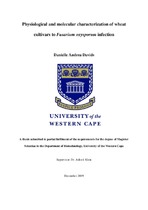| dc.description.abstract | Biotic stress is one of the main causes for agricultural loss of economically important cereal crops. The increasing prevalence of biotic stress inflicted by fungal species such as Fusarium has significantly reduced yields and quality of cereals, threatening sustainable agriculture and food security worldwide. Interactions between wheat and Fusarium spp. such as Fusarium oxysporum promotes the accumulation of reactive oxygen species (ROS). Overproduction of ROS can become toxic to plants depending on the scavenging ability of antioxidant systems to maintain redox homeostasis. This study investigated the effects of F. oxysporum on the physiological and biochemical response of three wheat cultivars namely, SST 056, SST 088 and SST 015. Physiological responses were monitored by measuring changes observed in plant growth parameters including shoot and root growth and biomass, relative water content as well as photosynthetic metabolism and osmolyte content in all three wheat cultivars. Downstream biochemical analysis involved monitoring the accumulation of ROS biomarkers (superoxide and hydrogen peroxide) as well as the detection of enzymatic activity of superoxide dismutase (SOD), ascorbate peroxidase (APX) and peroxidase (POD). These biochemical responses were only monitored on the two wheat cultivars which presented contrasting responses to F. oxysporum infection. Results showed that F. oxysporum significantly reduced plant growth, biomass, chlorophyll pigments and relative water content of all three cultivars, with the highest reduction observed for SST 088 relative to SST 015 and SST056. On the other hand, proline content was significantly enhanced in all three wheat cultivars, with the highest increase observed for SST 015 relative to SST 056 and SST 088. Based on the contrasting physiological results observed for these three cultivars, downstream biochemical analysis was focused on SST 015 and SST 088. F. oxysporum trigged an increased in superoxide and hydrogen peroxide contents in both cultivars, with the highest increase observed for SST 088. A similar trend was observed for the extent of lipid peroxidation, manifested as enhanced MDA levels. Furthermore, F. oxysporum differentially altered antioxidant enzyme activity relative to the control of both wheat cultivars. A Significant increase in SOD activity was observed for both cultivars in response to F. oxysporum. However, contrasting responses in APX and POD activity (as seen for the band intensities of individual isoforms) was observed in these wheat cultivars in response to F. oxysporum. Based on the results obtained in this study we suggest that F. oxysporum infection has varying degrees of severity in different wheat cultivars. In light of the significant reduction of plant development coupled with enhanced ROS accumulation and differential antioxidant capacity for SST 015 relative SST 088, we suggest that SST 015 is more resilient to F. oxysporum. We thus conclude that a direct relationship exists between ROS accumulation and antioxidant scavenging in regulating plant tolerance against F. oxysporum pathogens. | en_US |

